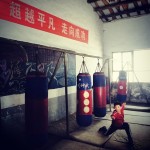I wrote a couple stories, one for Fightland about 36 Elbows, and another for Roads and Kingdoms about Kungfu and MMA, and these stories helped me move a little further down the road in terms of clarifying and understanding what it is that is happening in Chinese martial arts today.
The stories themselves are, for me, nice to see online, but are actually exercises in exorcising assumptions really. And gauging reactions in a way as well. One of the best reactions came, as always, from Ben Judkins of Kungfu Tea, who posed a series of questions that caused my ideas to reset …
“I think that that the big question that this piece begs, and one of the issues that really needs to be dealt with as we think about the traditional Chinese martial arts, is the role of “the market.” This is a touchy subject. People always associate the traditional arts with Daoism and Buddhism but in reality they were much more saturated in a folk neo-Confucian more than anything else. I suspect that even a lot of the mysticism in the traditional martial arts (breathing exercises, meditation, Qi flows) owes more to late Qing Confucian metaphysical schools than it does actual Buddhism.
I bring this up because the Confucians had a real problem with the idea of markets, commerce and “selling your skills.” You really have to take a moment and ask yourself some questions here. Why exactly is commercialism a bad thing again? If you are actually trying to promote the traditional schools its not. Markets are the best mechanism that we have for spreading this knowledge. [In] fact, the actual origins of Kung Fu lies in commercial markets. There was a market for caravan guards, for archery instruction, for local toughs, for opera performers who could fight on stage, for body guards, for traditional medicine focusing on qigong. This is where the world of Kung Fu comes from. It was a biproduct of the urbanization of Chinese society starting in the Song dynasty, but not really taking off and exploding until the Ming and later Qing dynasties.”
Right? Isn’t it interesting that martial artists and fans and writers take for granted the idea of the secluded, meditating master, when in fact that image is a romanticized, even orientalist depiction. The quaint image of the anachronism kept in place as a tourist attraction – as a place where “we” can go and visit, but leave again when the real world calls – is actually damaging to the very thing we hope to preserve: knowledge and lore and skill. Without markets, where would the master be? Grumbling in the hills about a lack of students, that’s where.
And if you talk about markets and fighting today you have to talk about combat sports, MMA, and promotions like the UFC. The markets aren’t calling for archers or caravan guards, but gladiators and heroes through whom we live vicariously. The markets are also calling for fair, unbiased, corruption-free fights. Hence the uproar when Diego Sanchez came away with a controversial decision. Here is Fightland’s Michael Hresko on that fight: Groupthink in MMA: The Diego Sanchez Win
The successful masters I know all speak of marketing as a tool and skill as important as flexible hips and a good 1-2 combo. Just as a good martial artist adapts to his opponent, a good marketing strategy must adapt to supply and demand.
Adaptation and innovation and change preserves like no other agent.
Isn’t that an interesting idea? In fighting, the static man loses, in business the stagnant company gets eaten up, in martial arts the unchanged faces oblivion. True?
Ben went a little further, and prodded another assumption, that of the full time kungfu teacher:
If I may, there is another (related) issue I think that we should consider. Why is there an expectation that there should be full-time Kung Fu teachers in the first place. Outside of a handful of really big schools and university programs, do we actually need them? There is actually nothing “traditional” about this expectation. Traditionally most martial arts students had day jobs, as guards, grocers, solider, performers, doctors or something else. Opening a school was usually seen as a retirement job. And to be totally honest, when I look at Hong Kong, someplace where the traditional arts are seemingly doing much better BTW, that is still the basic pattern that I see today. Sure there are a handful of schools with young dedicated Sifus, but most of the guys who are teaching full time had a full career doing something else first. Why exactly is that a bad thing?
I suspect that the martial arts went through an artificially good time in the 1980s and 1990s. There was a lot of popular enthusiasm for them, there weren’t that many other entertainment opportunities that they were competing against, and there was lots of government support. That led to people developing a somewhat unrealistic set of assumptions about what the world of Kung Fu “should be.” But honestly I think that the market is the only structure that can actually answer that question for you. Unless you are planning on using the government to force people to study Kung Fu (which is something else that gets tried from time to time), you can’t sell people something they don’t want. So its imperative to figure out what they do want.
******



